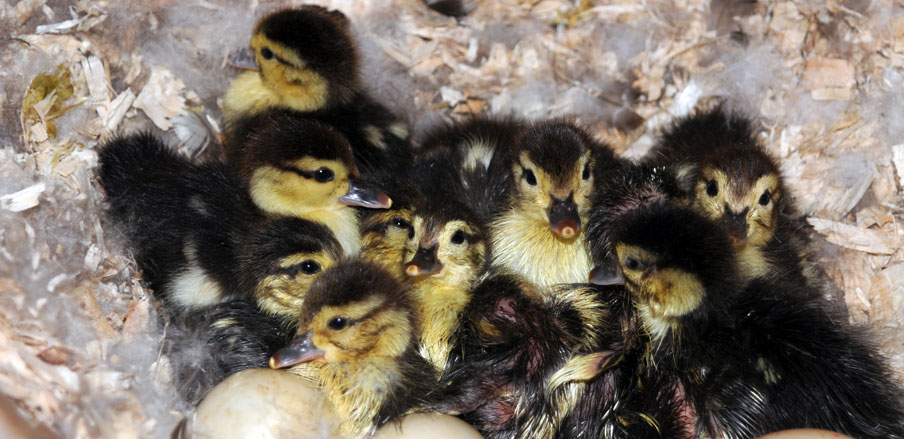Welcome to Relaxed Farming
- Alpacas
- Chickens
- Dairy Goats
- Ducks
- Geese
- Pigs
- Pygmy Goats
- Quail
- Rabbits
- Sheep
- Turkeys
- Polytunnel
- Photo Stories
- Video Stories
- Food
- Smallholding Map
- 2013
- 2014


- August
- September
- October
- November
- December
- January
- February
- March
- April
- May
- June
- July
- August


- 1
- 2
- 3
- 4
- 5
- 6
- 7
- 8
- 9
- 10
- 11
- 12
- 13
- 14
- 15
- 16
- 17
- 18
- 19
- 20
- 21
- 22
- 23
- 24
- 25
- 26
- 27
- 28
- 29
- 30
- 31
Saturday, 24th May 2014
Our single Muscovy duckling has been joined by quite a few others... First thing this morning we could hear a fair bit of cheeping coming from under Pear and then, in the middle of the afternoon we spied her in the paddock having a quick feed and swim, so took the opportunity to sneak a look in the nest. We are not actually sure how many are here: twelve or thirteen we think (how many can you count?) and with six eggs left, this number may grow. They really are very cute bundles of fluff! The pinkness on the chicks in the foreground shows that these must be the most recent to have hatched as they are still wet. You can also see the egg tooth on a lot of the beaks - this is used to help break out of the shells (see 26th April`).
For the first 24-48 hours of their lives, newly hatched ducklings and chicks do not need to eat or drink. This is because the remains of the yolk from the egg is absorbed into their abdomen and will provide enough nutrients for them to live. This is great news for the newly hatched birds, as those first few hours are best spent under mum drying out, keeping warm and getting used to not being all scrunched up in the egg. We popped some food and water in the house this evening so that mum can start feeding the ducklings tomorrow. We imagine she will keep them in the house for the next day or so and then hopefully start to encourage them out into the big wide world.
That is the good news. Not so good news is that after the mysterious death of our three females and a chat to our vet we have now definitely made the decision to cull our remaining quail. The most likely cause of death is some nasty bacteria. One of the males is not looking so good, but it is likely that both males have the bacteria lurking inside them and so could pass it on to other birds. We now need to clean and disinfect the aviary to make sure it is spotless for when our quail eggs start to hatch in a couple of weeks.
On the magpie front we are now unfortunately considering using a Larsen trap (see 15th May). We would need to buy at least three or four decoy birds to cover the barn and poultry paddock and guidance suggests they work well for a few weeks but then different ones may need to be used... A decision needs to be made soon: we have seen so many around today and we are not sure if the nest above the barn still has young but if it does, then when they fledge we are going to have an awful lot more...
